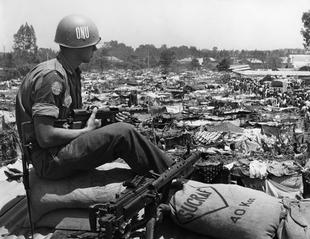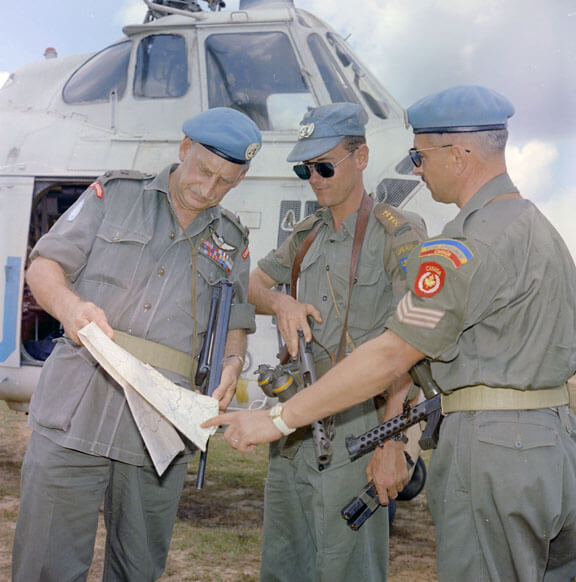
United Nations soldier in the Congo. [Wikimedia]
He declared that Canada would make a sizeable contribution to the United Nations intervention in the Democratic Republic of Congo.
But Diefenbaker was hardly acting on his own accord.
“When we discussed the Congo in Nassau,” one note from the United Kingdom foreign secretary wrote in 1963, “Diefenbaker told me that he thought that it was a mistake for the United Nations to get involved in fighting in the Congo to impose a political pattern on the country.”
The happenings in the central African country had not been far from Canada’s mind since its liberation from Belgium’s 90-year colonial grip on June 30, 1960. But even though the Congo overflowed with natural resources and abundant rainforests, it faced extreme poverty and famine, alongside the growing pains of new-found independence like political in-fighting and mutiny, inter-tribal disputes, public violence and persistent Belgian intervention.
But when the Katanga province declared independence from the rest of the nation, the freshly appointed Congolese president, Patrice Lumumba, called upon the United Nations for help.

Lieutenant Colonel Paul Augustus Mayer reviews a map with fellow Canadian soldiers. [MilArt photo archive]
Ottawa agreed with the National Defence Headquarters to steer clear of this peacekeeping mission in favour of saving dwindling funds
The UN Security Council’s response was speedy, approving the formation of the Organisation des Nations Unies au Congo (ONUC) on July 13 to restore order in the Congo, and this response would consequently sway the court of Canadian opinion in favour of national participation.
“Pearson’s Nobel Prize for his work during the Suez Crisis had put peacekeeping on the Canadian government’s agenda,” J.L. Granatstein and Norman Hillmer wrote in Empire to Umpire: Canada and the World into the Twenty-First Century.
So, when Ottawa agreed with National Defence Headquarters to steer clear of this peacekeeping mission in favour of saving dwindling funds while maintaining focus on the more imminent threat of the Soviet Union, Canadian media outlets were insatiable.
While The Globe and Mail described Canada’s contribution to the Congo as “meagre,” the Ottawa Journal had stated its hope for an “imaginative and wide-visioned and generous” response from the Canadian government. Peacekeeping was Canada’s claim to fame after all, so why would the government deny Lumumba’s request by only sending a few aircraft, staff officers and communications personnel to the African state?
Wading through sharper condemnations of the government’s actions, Diefenbaker had little choice left: the government would send a maximum of 500 soldiers and bilingual army signallers for the predominantly French-speaking Congo.
“The affair was significant from the Canadian point of view in that Ottawa had been virtually forced into major participation by public opinion,” Granatstein and Hillmer wrote.
Still, despite its lengthy involvement in the Congo, the Canadian government’s initial hesitation was something Diefenbaker was unable to live down.
Starting on Sept. 2, over 300 Canadians would serve alongside more than 20,000 United Nations personnel to help stabilize the Congo, but the peacekeepers quickly found they had their work cut out for them.
“Their skin colour, their uniforms, and their language were not dissimilar to those of the hated Belgians, and in a number of incidents Congolese troops beat Canadians and threatened worse,” Granatstein and Hillmer wrote.
Coupled with the Congo’s innated aggression against international interference, full-scale war ensued from breakaway states of the Congo like Katanga as well as meddlesome foreign mercenaries.
“The scope of the UN peacekeeping operation in the Congo pushed the definition of that term to the limit,” the Loyal Edmonton Regiment Museum wrote.
The financial burden of the mission was cumbersome, too, with the United Nations almost going bankrupt from the near four-year enterprise. It was only on June 30, 1964, that the wearied and worn Canadian troops finally returned home.
Still, despite its lengthy involvement in the Congo, the Canadian government’s initial hesitation was something Diefenbaker was unable to live down.
“Diefenbaker had seemed a laggard,” Granatstein and Hillmer wrote, “and his hesitancy over the Congo force was just one of many areas of foreign policy in which his government managed to portray itself as both unsure and overcautious.”
Additionally, this would not be the last time the Congo faced turbulence.
Throughout the mid-1990s, Rwandan and Burundi refugees infiltrated the eastern sections of the nation, causing massive conflict. Once again, Canada would try to remedy the situation by sending over 350 Canadians in 1996 to provide humanitarian aid and refugee return.
Even so, Diefenbaker’s ultimate folding to Canadian opinion back in 1960 proved the importance of peacekeeping to Canada’s cultural image.
“[Peacekeeping] differentiated Canada from most other countries,” Granatstein and Hillmer wrote, “it appeared to strike a responsive chord in the Canadian psyche.”
Advertisement





















